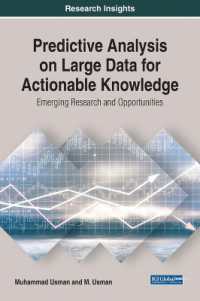- ホーム
- > 洋書
- > 英文書
- > Nature / Ecology
Full Description
These charismatic mammals, which include dogs, cats, hyenas, weasels, mongooses, seals, sea lions and bears, have always held special importance to humans throughout history and continue to do so today. In recent decades, the emergence of new technologies has completely transformed our knowledge of how carnivorans interact with their environments and consequently reshaped our view of carnivoran ecology.
This unique synthesis uses examples from a diverse and expanding carnivoran literature, drawing from all carnivoran families and spanning the world's oceans and continents, to produce a clearly written and richly illustrated book that reviews our current state of knowledge of carnivoran ecology. It addresses all levels of biological organization and function, from genes to enzymes, organisms, populations, and ecosystems. Special attention is given to how carnivoran species interact with their prey, each other, and humans. There is an emphasis on community interactions and their importance in carnivoran evolution, showing how evolutionary constraints (morphological, physiological, and behavioral) structure communities today. The book's approach is strongly comparative, contrasting herbivores with carnivores, predators with scavengers, and cats with dogs. Carnivorans play important roles in many high-profile conservation cases, either as species of concern or agents of endangerment, and their importance is demonstrated in both contexts.
Carnivoran Ecology is an accessible advanced textbook aimed principally at senior undergraduate and graduate students taking courses in carnivore ecology, as well as a broad audience of professional academics (especially carnivore and mammalian biologists), researchers, and practitioners working in both governmental and non-governmental organizations. A significant secondary market will exist amongst the large amateur naturalist community including those wishing to explore the ecological and evolutionary links between domestic carnivorans (dogs, cats, ferrets etc.) and their wild counterparts.
Contents
1: Introduction
2: Functional morphology
3: Evolution and historical biogeography
4: Physiological ecology
5: Sensory biology and neuroanatomy
6: Community ecology
7: Interactions with non-prey animals
8: Interactions with prey
9: Cascades
10: Population ecology
11: How carnivorans affect humans
12: How humans affect carnivorans
Appendix I
List of extant carnivoran species
Appendix II
List of non-carnivoran species mentioned







